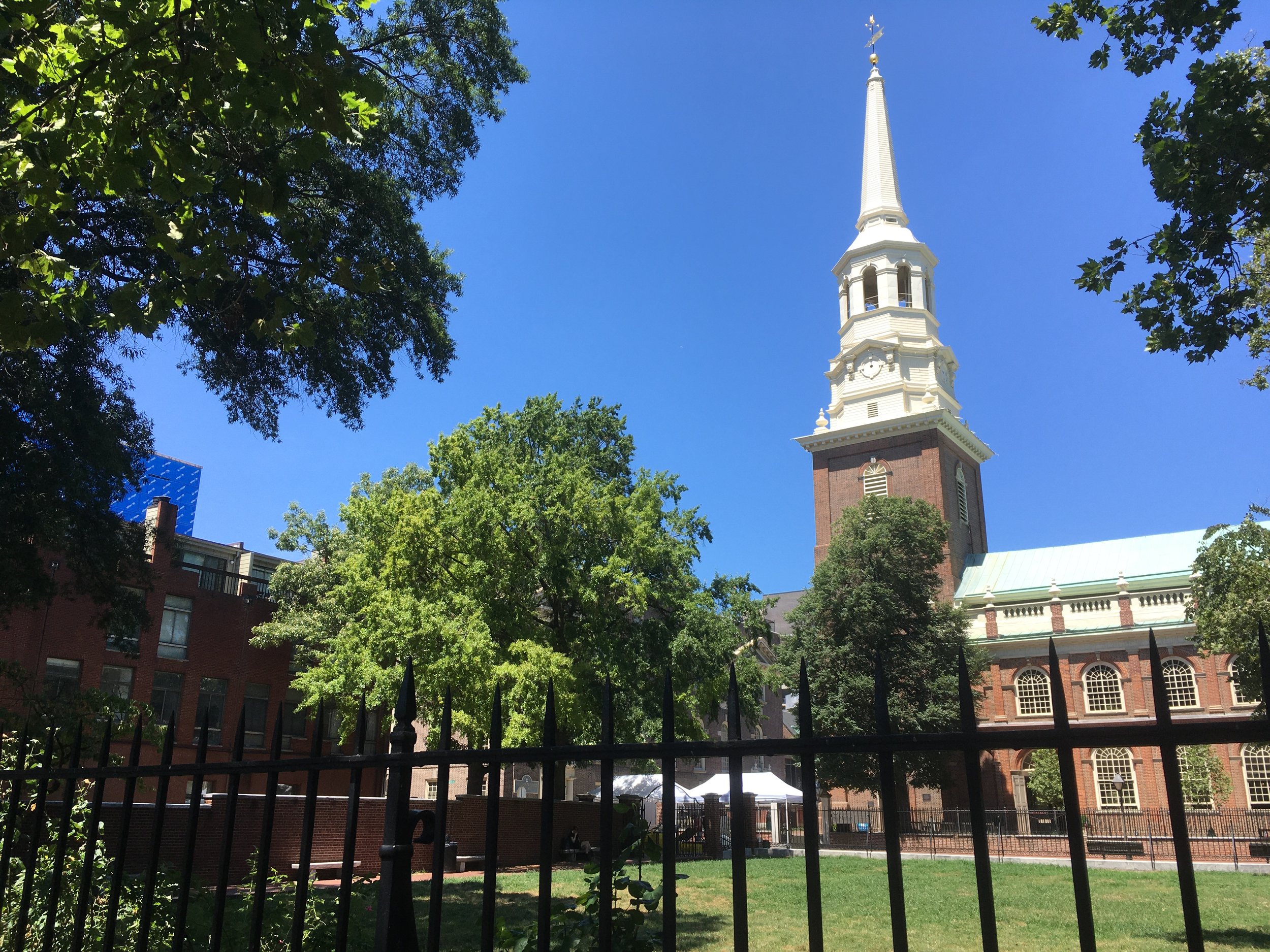Whose Is Taller …
Christ Church’s steeple or St. Peter’s?
Christ Church’s 196-foot-high steeple made it the tallest building in America for 56 years. Photo by Jim Murphy, author of Real Philly History, Real Fast.
Mike Teti, a fellow member of the Association of Philadelphia Tour Guides, recently asked me: “Which steeple is higher: Christ Church’s or St. Peter’s”?
I thought I knew the answer — but I was wrong
I’ve long known that Christ Church’s 196-foot-high steeple, added by master builder Robert Smith in 1754, made it the tallest building in the U.S. for 56 years. And the tallest in Philadelphia for over 100 years.
But I had no idea Christ Church was overtaken as tallest steeple in the Old City/Society Hill area some 180 years ago.
St. Peter’s “overextended” steeple has surpassed Christ Church’s in height since the 1840s. Almost no one knows this. I sure didn’t. Photo by Jim Murphy.
St. Peter’s is the winner
Church historian and parishioner Libby Brown, in a video on St. Peter’s website, confirms the fact. “The spire is a few feet taller than the Christ Church tower, perhaps our own Declaration of Independence,” she says.
Actually, says parish administrator Kate Randall, St. Peter’s steeple is 210 feet high. That makes it 14 feet taller than Christ Church’s steeple. Barbara Hogue, executive director at Christ Church, confirms the 196-foot height of its famous steeple.
I was amazed at the result. I doubt many people know St. Peter’s steeple has quietly lorded it over Christ Church’s since the early 1840s.
An overreach?
Because I live close to St. Peter’s Church, I see its steeple reaching for the sky every day. Maybe I should say overreaching, because the towering steeple looks a little out of proportion.
And it is. Probably intentionally.
Ten years after the two churches split into separate corporations in 1832, the vestry at St. Peter’s hired noted architect William Strickland to add a bell tower and steeple. And possibly to make a statement about its importance and independence as a new-found rival.
Strickland built an oversized steeple
In his graduate program thesis at the University of Pennsylvania, Frederick Lee Richards, whose father was the rector of St. Peter’s Church from 1970 to 1985, refers to the “overscale of the tower to the rest of the building.”
He adds: “Constance Greiff has suggested that the ‘abandonment’ of the classical orders with their strict rules of proportion by the 1840s created an environment in American architecture where Strickland would have felt free to exaggerate his proportions.”
Another possibility: “Perhaps, the vestry told Strickland they wanted a prominent structure that would mark St. Peter’s on the skyline like Christ Church.”
The Society of Architectural Historians says this in the SAH Archipedia: “In 1842, the separation of St. Peter's from Christ Church was symbolized by the construction of William Strickland's great spire, taller even than Christ Church's lofty spire.”
Interesting Oddities:
Christ Church had problems getting its bells rung on July 4, 1801. Ringers refused to work “because they were not specifically paid for their trouble” … and were the subject of numerous Vestrymen meetings later that year.
Robert Smith, Philly’s most important Colonial builder/architect, worked on both churches. He designed the steeple at Christ Church and led the construction of St. Peter’s Church.
Christ Church’s steeple has a gilded bishop’s mitre installed near the top. It sits right below a copper trident-shaped scepter that serves as a lightning rod. St. Peter’s steeple, on the other hand, has a cross at the top. That was considered a sign of the Church of Rome and unsuitable for an Anglican Church in the 1700s. By 1842, rector Rev. William H. Odenheimer convinced the vestry to place a 10-foot gilt cross on the steeple, one of the earlier Episcopal churches to do so.
Some Sources:
http://alanjheavens.blogspot.com/p/st-peters-timeline.html
https://christchurchphila.org/steeple/
https://libwww.freelibrary.org/digital/item/pdce00289
https://npgallery.nps.gov/GetAsset/5c7d0d09-b13f-4345-a960-ec90d570b5a7
http://npshistory.com/publications/inde/nr-christ-church.pdf
https://repository.upenn.edu/cgi/viewcontent.cgi?article=1428&context=hp_theses
https://sah-archipedia.org/buildings/PA-02-PH18
https://whyy.org/articles/philadelphias-christ-church-preserves-historic-steeple/
https://www.philageohistory.org/rdic-images/view-book.cfm/ChristChurch.MinuteBooks_v3
https://www.stpetersphila.org/about-st-peters/history/
Richards, Frederick Lee (1992). “Old St. Peter’s Protestant Episcopal Church, Philadelphia: An Architectural History and Inventory (1758–1991).” (Masters Thesis). University of Pennsylvania, Philadelphia, PA.

